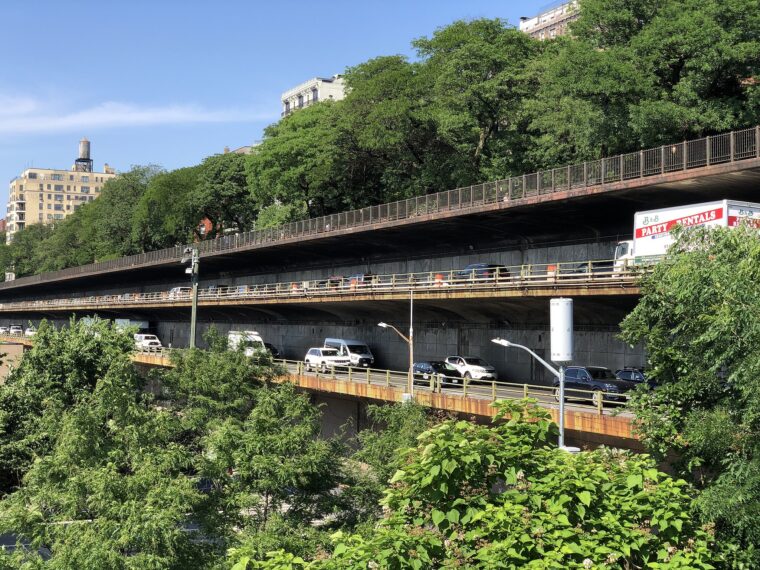
The New York City Department of Transportation (NYC DOT) has unveiled plans to make the Brooklyn-Queens Expressway (BQE) in Brooklyn safer and more connected, while also creating better public spaces. These ideas were outlined in a new report called BQE North and South: Safe, Sustainable, Connected, which showcases the city’s vision for improving the BQE.
The report offers many short-, medium- and long-term ideas, like redesigning streets and intersections, adding bike and bus lanes, capping parts of the highway to create new public spaces and building new plazas to boost safety and reconnect communities that were split by the highway.
RELATED: Funding to build deck parks over Dallas highway approved by city council
“The bold concepts outlined in this report would invest in working-class neighborhoods and reconnect communities long divided by the Brooklyn-Queens Expressway,” NYC DOT Commissioner Ydanis Rodriguez says. “Through a corridorwide approach, we can equitably address safety, public space and connectivity needs for neighborhoods that have often been left out of conversations around the BQE.”
The agency plans to use this framework to solicit more public input, and all the proposals will undergo further study to determine feasibility, with some projects already slated to start before the end of 2025.
The city will also work with the New York State Department of Transportation (NYSDOT) to move forward with future projects along parts of the BQE owned by the state, if needed. The agencies will collaborate on at least one major project in both the BQE North and South sections, supported by a $5.6 million federal grant meant to improve neighborhoods along the highway.
The concepts announced include:
Streetscape and Safety Enhancements: Redesigning streets along and across the BQE corridor to prioritize safety for all road users. New pedestrian plazas and public spaces can be created by closing slip lanes and short street sections near triangle parks. NYC DOT plans to begin these projects using its own resources in the short term but may later develop them into larger, permanent capital projects.
Intersection Redesigns Near BQE Ramps: NYC DOT will investigate ways to improve safety and traffic flow at certain ramps where vehicles enter or exit the highway. These areas often have unique intersection designs, which will require ongoing data collection, input from the community and partnering with NYSDOT.
New Uses for Spaces Under the BQE: The spaces beneath the elevated BQE can be repurposed for markets, community centers, bike parking, electric vehicle charging stations, metered parking and other community improvements.
Capping the BQE Trench: Public spaces can also be created through capping concepts where the highway runs below grade. These long-term projects will require close cooperation with NYSDOT.
Maintenance: During discussions about BQE North and South, participants highlighted the need for better cleaning under and along the BQE. To improve the city’s cleaning efforts, which are already supported by the Department of Sanitation and NYSDOT, the agency has already acquired additional resources through a contract transfer and will schedule more regular cleanings in key areas. NYC DOT and NYSDOT are also holding regular meetings to coordinate maintenance and construction management in the area.
With the BQE report, NYC DOT is prioritizing equality by focusing on safety and public space improvements in neighborhoods long separated by the highway. The ideas in the report are shaped by input from 2,600 residents who participated in in-person and virtual workshops, as well as online surveys.
The city is looking at the BQE corridor in Brooklyn in three parts:
BQE North, which stretches from the Kosciuszko Bridge to Sands Street.
BQE Central, from Atlantic Avenue to Sands Street.
BQE South, from Atlantic Avenue to the Verrazzano-Narrows Bridge.
The city owns the central section, about 12% of the highway in Brooklyn, while the state owns the north and south sections. The city is also responsible for maintaining the streets and sidewalks underneath and around the entire expressway. NYC DOT will move forward with plans for BQE North and South covered by the report while New York City works on a long-term solution for BQE Central.
Photo courtesy Famartin
The post NYC plans to reconnect neighborhoods separated by Brooklyn-Queens Expressway construction appeared first on Government Market News.
